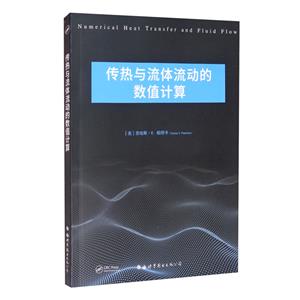包郵 Numerical heat transfer and fluid flow
-
>
宇宙、量子和人類心靈
-
>
氣候文明史
-
>
南極100天
-
>
考研數(shù)學(xué)專題練1200題
-
>
希格斯:“上帝粒子”的發(fā)明與發(fā)現(xiàn)
-
>
神農(nóng)架疊層石:10多億年前遠(yuǎn)古海洋微生物建造的大堡礁
-
>
聲音簡(jiǎn)史
Numerical heat transfer and fluid flow 版權(quán)信息
- ISBN:9787519283261
- 條形碼:9787519283261 ; 978-7-5192-8326-1
- 裝幀:一般膠版紙
- 冊(cè)數(shù):暫無(wú)
- 重量:暫無(wú)
- 所屬分類:>>
Numerical heat transfer and fluid flow 內(nèi)容簡(jiǎn)介
To illustrate the application of the material,problems are given at the end of some chapters. Most of the problems can be solved by using a pocket calculator,although some of them should be programmed for a digital computer.The problems are not meant for testing the student reader,but are included primarily for extending and enriching the learning process. They suggest alternative techniques and present additional material. At times,in my attempt to give a hint for the problem solution,I almost disclose the full answer. In such cases,arriving at the correct answer is not the main objective;the reader should focus on the message that the problem is designed to convey. This book carries the description of the numerical method to a point where the reader could begin to write a computer program. Indeed,the reader should be able to construct computer programs that generate the kind of results presented in the final chapter of the book. A range of computer programs of varying generality can be designed depending upon the nature of the problems to be solved. Many readers might have found it helpful if a representative computer program were included in tlus book. I did consider the possibility. However,the task of providing a reasonably general computer program,its detailed description,and several examples of its use seemed so formidable that it would have considerably delayed the publication of this book. For the time being,I have included a section on the preparation and testing of a computer program(Section 7.4),where many useful procedures and practices gathered through experience are described.
Numerical heat transfer and fluid flow 目錄
1 INTRODUCTION
1.1 Scope of the Book
1.2 Methods of Prediction
1.2-1 Experimental Investigation
1.2-2 Theoretical Calculation
1.2-3 Advantages of a Theoretical Calculation
1.2-4 Disadvantages of a Theoretical Calculation
1.2-5 Choice of Prediction Method
1.3 Outline of the Book
2 MATHEMATICAL DESCRIPTION OF PHYSICAL PHENOMENA
2.1 Governing Differential Equations
2.1-1 Meaning of a Differential Equation
2.1-2 Conservation of a Chemical Species
2.1-3 The Energy Equation
2.1-4 A Momentum Equation
2.1 5 The Time-Averaged Equations for Turbulent Flow
2.1-6 The Turbulence-Kinetic-Energy Equation
2.1-7 The General Differential Equation
2.2 Nature of Coordinates
2.2-1 Independent Variables
2.2-2 Proper Choice of Coordinates
2.2-3 One-Way and Two-Way Coordinates
Problems
3 DISCRETIZATION METHODS
3.1 The Nature of Numerical Methods
3,1-1 The Task
3,1 2 The Discretization Concept
3.1-3 The Structure of the Discretization Equation
3.2 Methods of Deriving the Discretization Equations
3.2-1 Taylor-Series Formulation
3.2-2 Variational Formulation
3.2-3 Method of Weighted Residuals
3.2-4 Control-Volume Formulation
3.3 An Illustrative Example
3.4 The Four Basic Rules
3.5 Closure
Problems
4 HEAT CONDUCTION
4.1 Objectives of the Chapter
4.2 Steady One-dimensional Conduction
4.2-1 The Basic Equations
4.2-2 The Grid Spacing
4.2-3 The Interface Conductmty
4.2-4 Nonlinearity
4.2-5 Source-Term Linearization
4.2-6 Boundary Conditions
4.2-7 Solution of the Linear Algebraic Equations
4.3 Unsteady One-dimensional Conduction
4.3-1 The General Discretization Equation
4.3-2 Explicit, Crank-Nicolson, and Fully Implicit Schemes
4.3-3 The Fully Implicit Discretization Equation
4.4 Two- and Three-dimensional Situations
4.4-1 Discretization Equation for Two Dimensions
4.4-2 Discretization Equation for Three Dimensions
4.4-3 Solution of the Algebraic Equations
4.5 Overrelaxation and Underrelaxation
4.6 Some Geometric Considerations
4.6-1 Location of the Control-Volume Faces
4.6-2 Other Coordinate Systems
4.7 Closure
Problems
5 CONVECTION AND DIFFUSION
5.1 The Task
5.2 Steady One-dimensional Convection and Diffusion
5.2-1 A Preliminary Derivation
5.2-2 The Upwind Scheme
5.2-3 The Exact Solution
5.2-4 The Exponential Scheme
……
6 CALCULATION OF THE FLOW FIELD
7 FINISHING TOUCHES
8 SPECIAL TOPICS
9 ILLUSTRATIVE APPLICATIONS
Nomenclature
References
Index
Numerical heat transfer and fluid flow 作者簡(jiǎn)介
蘇哈斯·V. 帕坦卡(Suhas V. Patankar,1941年2月22日-)是擁有印度、美國(guó)雙重國(guó)籍的機(jī)械工程學(xué)家,明尼蘇達(dá)大學(xué)榮譽(yù)退休教授,專長(zhǎng)于計(jì)算流體力學(xué)。
- >
史學(xué)評(píng)論
- >
煙與鏡
- >
名家?guī)阕x魯迅:朝花夕拾
- >
巴金-再思錄
- >
新文學(xué)天穹兩巨星--魯迅與胡適/紅燭學(xué)術(shù)叢書(shū)(紅燭學(xué)術(shù)叢書(shū))
- >
自卑與超越
- >
名家?guī)阕x魯迅:故事新編
- >
伯納黛特,你要去哪(2021新版)
















